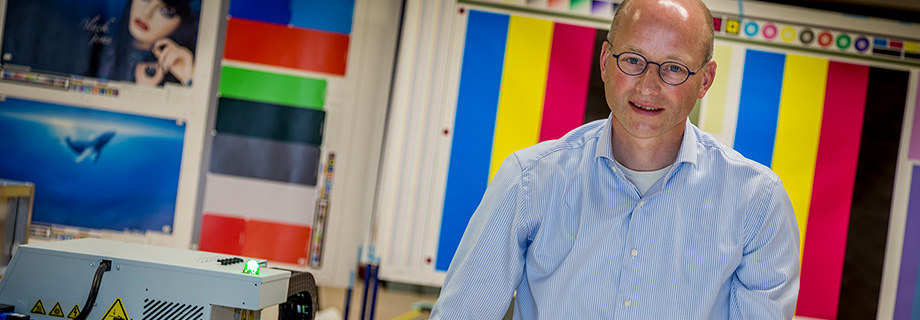You can be whatever you want to be
The market for digital printing is changing rapidly. We exist for over 140 years, and we are still busy exploring new markets. To do so, we need new people.
Canon Production Printing is a world leader in the field of digital printing systems, software and services for document production, reproduction, distribution and management for professional users. We have a worldwide presence and employs a workforce of 3000, including 1700 employees in Venlo, 700 of which work in R&D.
The head office is located in Venlo, in the heart of the European high-tech corridor.
Cooperating with people from different countries and different disciplines is especially interesting, says deputy director of R&D, Ernst Ullersma. ‘Canon Production Printing is among the top 10 R&D organisations in the Netherlands, and we have research centres in the Netherlands, Germany and Romania.’
‘We also support and fund around 100 PhD positions in Europe, which allows us to collaborate with universities in conducting fundamental research, which in turn helps us to improve our products and technologies. There is no such thing as monodisciplinary work at Canon Production Printing. From industrial design, mechanical engineering, and electronics, to physics, chemistry and software, it’s all about collaboration. Regardless of the problem, we always work in teams to come up with solutions together. Looking beyond the scope of your own field is very important, and you should be open to do so if you work here.’
When it comes to digital printing, major changes are taking place in the market. In the past, copying was all that mattered, but printing has gained primacy over the years. We started producing printers that were used by companies and large institutes to print reports and readers. We also had a major presence in the blueprint market, which involved printing large-scale architectural drawings, for instance, but digitisation had caused that market to decline.
How do we deal with the changing market?
‘A large part of our printer revenue comes from our installed base. Our existing printers still represent revenue flows: we continue to support these products, of course, keeping the software up-to-date, and replacing any printer components that need to be replaced.
‘On top of that, we’re also focusing on growth markets, such as the graphics market. We produce printers that let you print banners, for instance, such as the ‘back to school’ banners you’ll find on public roads in August. We’ve also developed large-format printers, such as the Colorado 1650, which can be used to print a few relatively small banners, as well as high-volume batches.’
‘We have also started developing printers that can quickly process large print runs at low cost. A lot of on-demand book printing parties use the printers that we have developed, and seeing as the book market is still 90% analog, there’s a lot of ground to be gained there. Digital systems make it easy to reprint copies of best-sellers that were first published 10 years ago, and that will be the case for many more products in the future. In the distant future, you could even order clothes printed to your precise specs and wishes.’
Canon Production Printing is already involved in a project that uses a 3D printer to create dental prostheses. Is 3D printing an obvious choice for a company that has always mainly dealt with paper?
‘Yes, it makes sense technologically. Printing drops of ink on paper or printing objects such as a tooth isn’t actually that different: you need the same expertise. NextDent and TNO are able to create these dental prostheses thanks to technology that we’ve developed and made available to them. It’s a great match for our skills. For us, these activities have an exploratory function, they’re ways to research new technologies and explore new markets.’
‘Elevated printing is another project that has attracted a lot of attention. We have used this technology to print reproductions of Vermeer’s Girl with the Pearl Earring and Van Gogh’s Sunflowers, among others. These projects show how well we’ve mastered this technology, proving that we’re ahead of the curve when it comes to applications of inkjet technology. We’re very proud of the fact that we have the upper hand over our competitors.’
You’ll be needing people to shape that innovation. Who are you mainly looking for?
‘We’d prefer people who are looking to develop themselves in the coming years, so that they can take up a pivotal position within R&D within 5-10 years. These might be people driving the development of new technologies, but also people capable of leading a department. We are just as appealing for recent graduates as for people who already have work experience.’
What makes Canon Production Printing an appealing place to work?
‘The main reason that it’s such a great place to work is our company culture and the way we’re organised. People enjoy working on meaningful, beautiful projects, but for most employees it’s just as important that they’re given freedom to develop. When people are ready for the next step, we’ll give them that opportunity. We’re not at all averse to change.’
‘One of the things we do is drive decisions as far down the organisation as is responsible to do. We assume that people who have a thorough understanding of a topic will be able to make better decisions than managers. If our people feel comfortable in that role, we like giving them responsibility and the feeling that they mean something in the organisation. That’s very important to us. It can take some time for managers to get used to transferring responsibility, but it does ultimately lead to good solutions.’
‘We’ll give you your space and encourage you to try out and explore new directions, supporting your development by means of broad training opportunities and ample room for technological innovation. At Canon Production Printing, you can be whatever you want to be.’







